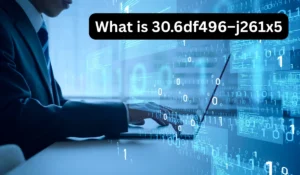
a0deb33d5b6c59da2a370840df058c6b
Introduction
A0deb33d5b6c59da2a370840df058c6b today’s digital world, cryptic codes and alphanumeric strings are everywhere—from software and databases to cybersecurity platforms and online tools. One such mysterious identifier is a0deb33d5b6c59da2a370840df058c6b While to the average user it may appear to be a random mix of characters, it likely holds more significance than meets the eye. Such strings are often linked with hash functions, file identifiers, encryption keys, or even potential malware.
Understanding what these codes represent is crucial, especially when they’re found in suspicious environments or embedded within software and system files. This article explores the origin, potential function, and cybersecurity implications of the identifier a0deb33d5b6c59da2a370840df058c6b. Whether you’re a curious tech enthusiast, a cybersecurity professional, or someone who stumbled upon this string while browsing, you’re in the right place.
In the following sections, we’ll decode this seemingly random string, explore where it might be found online, and discuss its possible applications or risks. By the end, you’ll have a clearer understanding of what a0deb33d5b6c59da2a370840df058c6b might be and why it’s important to recognize such identifiers in today’s tech landscape.
What is a0deb33d5b6c59da2a370840df058c6b?
At first glance, the string a0deb33d5b6c59da2a370840df058c6b appears to be a meaningless sequence of numbers and letters. However, its 32-character length and format strongly suggest that it’s an MD5 hash—a widely used cryptographic function. MD5, or Message Digest Algorithm 5, takes an input (or message) and returns a fixed-size, 32-character hexadecimal hash. It’s commonly used to verify data integrity, generate digital signatures, or identify files uniquely.
Such hashes are frequently used in software environments to confirm whether files have been altered. If even a single byte of a file changes, the MD5 hash will be completely different. This makes it a powerful tool for checksums and integrity verification, especially in software distribution and cybersecurity.
In other cases, identifiers like a0deb33d5b6c59da2a370840df058c6b might represent a unique reference to a file in a malware database or be part of a dataset used by antivirus programs. While the code itself isn’t inherently dangerous, it may be associated with something that is—such as a known malware sample, a corrupted file, or a blacklisted application. Understanding what generates such hashes and where they’re stored is the first step in decoding their purpose.
Possible Origins and Technical Analysis
The most likely origin of a0deb33d5b6c59da2a370840df058c6b is as an MD5 hash generated by a file, text string, or digital artifact. MD5 hashes are deterministic, meaning the same input always produces the same output. Thus, this particular hash was likely created from a specific input—perhaps a file, malware sample, or line of code.
To analyze such a hash, professionals often use hash lookup tools and forensic platforms like VirusTotal, Hybrid Analysis, or MetaDefender. These platforms allow users to search for hash values and determine whether they’re associated with known threats, software, or benign files. If the hash appears in one of these databases, it’s often linked with reports, metadata, and even behavioral analyses that shed light on the file’s nature.
Additionally, using reverse lookup tools or brute-force hash crackers may reveal the original input—though for MD5 hashes, this is rarely practical due to the irreversible design and complexity of the algorithm. It’s worth noting that while MD5 is still widely used, it is no longer considered cryptographically secure due to vulnerabilities like collision attacks.
Still, the hash may be embedded in software repositories like GitHub, code samples on Pastebin, or hidden within network logs. If discovered in a suspicious environment, it warrants further investigation.
Where Has a0deb33d5b6c59da2a370840df058c6b Been Seen Online?
To determine if a0deb33d5b6c59da2a370840df058c6b has appeared elsewhere on the web, cybersecurity analysts often search known malware databases or online threat intelligence repositories. VirusTotal.com is a go-to resource, where users can paste in a hash and instantly see if it matches any known files—malicious or otherwise. If the hash has been previously uploaded or scanned, it will appear alongside details about its source, file type, and any flags raised by antivirus engines.
Other platforms such as Hybrid Analysis, Any.Run, and ThreatFox also provide insight into where and how such hashes have surfaced. These platforms specialize in behavioral analysis and malware sandboxing, allowing users to investigate suspicious files or URLs by observing their behavior in a controlled environment.
In many cases, you might find this hash associated with a malware payload, phishing document, or even as part of a batch of leaked credentials or cracked software tools. Additionally, platforms like GitHub, Pastebin, and Dark Web forums are common places where hashes like this appear in connection with exploits or pirated software repositories.
The presence of a hash in any of these locations does not confirm malicious intent, but it should raise a red flag—especially if it shows up in environments known for digital threats.
Is a0deb33d5b6c59da2a370840df058c6b Safe or Harmful?
The hash a0deb33d5b6c59da2a370840df058c6b itself is not inherently dangerous—it’s simply a fingerprint. However, what it points to can pose a risk. If this hash corresponds to a malware file, spyware, or phishing tool, then its presence in your system or on a website should be taken seriously.
To assess the safety of such a hash, users can run it through security scanners or upload the suspected file (from which the hash was generated) to a platform like VirusTotal. These services aggregate results from multiple antivirus engines and provide a comprehensive threat analysis. If even a few engines flag the file as malicious, further scrutiny is warranted.
It’s also essential to look at the context. Did this hash appear in your antivirus logs? Was it embedded in an email attachment or linked in a suspicious URL? Contextual clues can help determine whether it’s associated with active threats or simply part of harmless system processes.
Ultimately, handling unknown hashes responsibly—by isolating files, scanning for malware, and using up-to-date cybersecurity tools—is the best way to protect your system. Ignoring such indicators, especially if they’re found during vulnerability scans or email filters, could lead to unnecessary risk exposure.
How to Handle Unknown Hashes and Strings Like a0deb33d5b6c59da2a370840df058c6b
When encountering a mysterious hash like a0deb33d5b6c59da2a370840df058c6b, it’s important not to jump to conclusions. Instead, follow a systematic approach to determine its relevance and risk. Begin by using reputable tools to search known databases for matches. If a match is found, carefully review the associated context, such as the file name, upload source, and behavioral reports.
Next, avoid executing or opening any files linked with the hash unless tested in a safe sandbox environment. Even if a file appears benign, it may contain hidden payloads that activate under specific conditions. For developers or researchers, it’s good practice to generate hashes for your own files to track changes or verify integrity.
Reporting suspicious hashes is another step in responsible digital hygiene. Cybersecurity platforms, antivirus vendors, and even public mailing lists welcome submissions of suspicious samples. This helps improve collective knowledge and threat detection rates across platforms.
Additionally, stay proactive by keeping systems updated, running periodic scans, and using intrusion detection systems (IDS) or endpoint protection platforms that monitor for hash-based indicators of compromise. Educating your team or household about the role of hashes in cybersecurity can go a long way in preventing threats.
Conclusion
The identifier a0deb33d5b6c59da2a370840df058c6b may seem like a random string, but it serves as a digital fingerprint with potentially significant implications. Whether it’s a harmless MD5 hash used in software verification or a dangerous marker for malware, knowing how to analyze and understand such codes is vital in the information age.
From technical breakdowns to online footprint analysis, this article has walked through the many facets of what a hash like a0deb33d5b6c59da2a370840df058c6b might represent. With the right tools and caution, users can stay one step ahead of threats and ensure that mysterious codes don’t go unchecked.
Also Read: Software Keepho5ll







